Common Pediatric Feeding Challenges
- Skill basics of sucking swallowing and chewing
- Developmental transitions
- Texture transitions
- Sensory sensitivity
- Motor challenges
- Worry
- Crumbs can help
Those of us that are working with feeding with children know that there are a lot of common challenges that we all face every day in supporting these children and their families. These are the basic skills of sucking, swallowing, and chewing. Children can have challenges with developmental and textural transitions. Children can have sensory sensitivity or oversensitivity, motor challenges, and many children have worry. They worry about making the transitions from one stage to another, and crumbs can help.
Child Success and Parent Success
- Child success
- Parent success
- Therapist success
- We want to celebrate the child and have them celebrate the mealtime!
Obviously, we really want children to be successful, but we also need to focus on parent success. It is not about what they will eat for us, but rather it is about what we can do to create the opportunity and the situation where parents can be successful with their children. We want to celebrate children, and we want them to feel celebrated. Thus, we are looking at feeding in the context of an entire mealtime.
Positive Versus Negative Tilt
When I think about the way we interact with children in feeding therapy and in my Get Permission classes, I talk about a positive and a negative tilt.
Positive Tilt
The parent offers and the child comes toward the parent. They come together in the center. The parent offers with the spoon or the bottle or the breast and says, "Do you want it?" And, the child says yes by opening their mouth and reaching for the food or the spoon. The parent and child come together at the midline, either physically or emotionally (Figure 1).

Figure 1. Example of a positive tilt.
In a positive tilt, things are working, but in a negative tilt, the parent is offering and the child is pulling away.
Negative Tilt
In a negative tilt, the child is saying, "Wait! I do not want it." Physically or emotionally, the child does not want what the caregiver is offering (Figure 2).

Figure 2. Example of a negative tilt.
We see this a lot in feeding. The children have to have the readiness to accept what we are offering them in feeding.
Get Permission Approach
- Adult offers and the child gives permission or not.
- Look at influences on permission carefully
- When no permission, we must adapt
- If the child is resisting, we are pressuring or asking too big an ask.
- What do WE need to do to offer so the child is able to give permission?
We talk about the adult offers, and then the child gives permission or not. When the child is not giving permission and is leaning away, turning away, closing their mouth, or saying "no," we want to make sure that we adapt. When the children do not give permission, we have to adapt our offer. If the child is resisting and pulling away, if the child is feeling pressured, or we are making too big of an ask, that means that we need to adjust. What do we need to do with our offer so that the child is able to give permission?
Continuum of Tasks
Crumbs are a really nice way to think about grading our ask. A continuum is a continuous sequence in which the adjacent elements are not perceptibly different from each other in little steps along the way, but the endpoints are very distinct. I think of it really as of how do we get from here to there. The important thing is that when getting from here to there that all the little steps along the continuum are tiny and not perceptibly different from each other. Crumbs are going to be a great way to do that.
Grade the Ask
- Safety ask
- Developmental ask
- Sensory ask
- Motor ask
- Emotional ask
- Independence ask
I am going to think about a way to grade the ask for children. We are asking them, "Would you like this?" "Does this work for you?" And, "What do we need to do to make it safe for you?" The first is our safety ask. Are we asking the child to do something that is safe? For example, are they able to swallow something without aspirating? Are we asking them to chew something they can chew without choking on it? Are we asking them to eat something that is not going to cause some allergic reaction or be really difficult for them? Are we grading our developmental ask? Are we asking the child to perform a developmental task they are ready for? If they are eating purees, obviously, we cannot give them a mouthful of steak. We are also going to look at grading our sensory ask. If they are comfortable with one texture, we need to make sure that we grade our sensory ask in terms of another texture, flavor, or sound. Is the motor ask something that the child can do? We have to grade that. We do not want to give too big of a piece of food, for example, or if we want a child to suck we need to give them the right supports to suck properly. Motor-wise, we want to make sure our ask is careful. We also need to grade the emotional ask. A lot of our children that we see for feeding therapy have worry and fear. They have nervousness about the next steps. We know the next steps we want them to try, but they know what feels good and right to them. We want to make sure we are asking something of the child they emotionally can do without pushing right directly into their fear and worry. Finally, independence ask is important because we are aiming for a child to be independent. When we involve them in feeding therapy, it is not going to be all about what we do to them, but it is going to be about helping them be active participants. They may be able to bring a fork or spoon to their mouth or finger feed. They could also just touch your hand as you are feeding them or open their mouth and look at the spoon to let you know they are ready. So, we need to make sure we are including them in the independence part of this ask and not just doing to them.
Art of Crumbing
- The prescriptive use of crumbs to help children be successful in new food textures, flavors, and chewing challenges.
- Support transitions in the sensory properties of the foods and the motor challenges
Crumbing is the prescriptive use of crumbs to help children be successful in new food textures, flavors, and chewing challenges. Figure 3 shows an example.
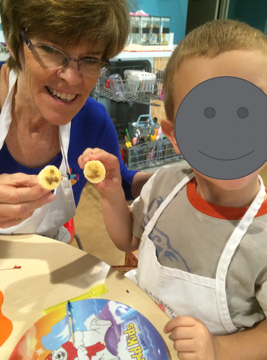
Figure 3. Crumb example.
We are going to use crumbs to support transitions in the sensory properties of food and in motor challenges.
Crumb Benefits
- Crumbs help the child build enjoyment while developing the confidence to work towards developmental texture acceptance and chewing.
- Sensory bridge
- Motor bridge
- Bridge to a new food group
- Reduce worry
There are so many benefits. One of the things I like about crumbs is that it helps build child enjoyment while they are developing confidence. We can make crumbs fun. Crumbs are little, and they are not as scary as other aspects of food a lot of times. They can be a sensory and a motor bridge. They could also be a bridge to a new food group, and they can help children reduce their worry.
Grade the Crumb (Sensory Ask)
- Grade the sound
- Grade the visual
- Grade the flavor
- Grade the texture…a texture bridge
- Grade the amount
- Grade the dry to wet and wet to dry
- Grade the “meltability”
- Grade the lasting effect (feel and flavor)
When we talk about grading the crumb ask, we can grade the sound. Think about some of the crackers and crunchy foods you know. Some are really loud. And when food is loud, you hear it in your ears and feel the sound in your jaw. We can grade the visual as well. Some children are really worried about visual differences in change. We can use crumbs to make them look similar or different. We can also grade the flavor, the texture, and the amount of the change. We can grade from dry to wet for kids who really like dry foods but not yet wet. Or, we can help children grade from wet to dry. We can grade the meltability, and we can even grade the lasting effect. The is the effect in your mouth after you have eaten food. A jalapeno has a lasting effect as an example. Some foods have a much more lasting effect than others, and we can use that as one of our sensory variables to pay attention to with kids.
Sensory Properties- Crumb Rehearsals
- Reduce the worry with rehearsals
- Vision-Look from a distance
- Sound-Hear it from a distance
- Smell-Taste from a distance
- Texture Touch-Experience the texture in the hand as a preview of the texture in the mouth
We are going to then look at the sensory properties of food when we are doing crumb rehearsals. We want to help children know what is coming next and get them prepared for this new thing that we are offering them. We want to also look at the distant version of the sensory properties we are talking about. You can have a rehearsal about what that crumb is going to be like. Sound has near and far sound. Children we work with are worried about sounds and many cover their ears all the time. Maybe they could hear somebody else crunching that cracker or somebody else walking by crunching that cracker, and that sound could get closer. So, sound can also be a rehearsal. Smell is a rehearsal as well because the smell is actually tasted from a distance. It is a taste without having the experience of it on your tongue. When you are around an orange slice or you are squeezing oranges, you know what that is going to taste like ahead of time. We can rehearse with the smells of crackers, like a ginger snap. Then, texture can be a sensory property that has a distant variable. In order to give their mouth a warning of what the texture might be like, we can have children touch it, experience it, and feel it in their palm. It is a preview or a rehearsal of what that texture is going to be like. Figure 4 demonstrates this. I can this a palm feel and a crumb kiss.
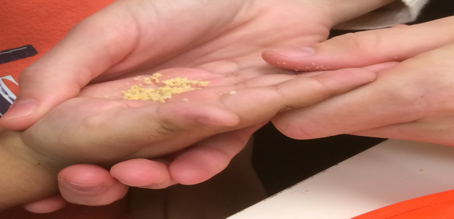
Figure 4. Example of a crumb rehearsal.
This little guy had been playing with crumbs so he could get a feel of what they were going to feel like ahead of time.
Different Types of Crumbs
This is where we get to use our imagination a little bit. We want to think about a few different kinds of crumbs. Imagine that you are taking these Ritz crackers (Figure 5), and you are going to crumb them up in your hand.
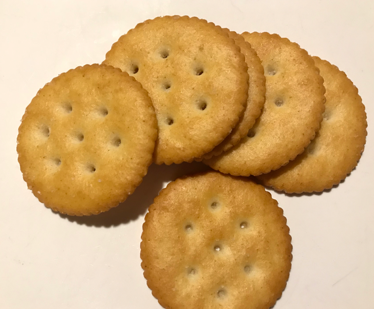
Figure 5. Ritz crackers.
Ritz crackers can make a pretty fine crumb with a little bit of buttery greasiness. If you put those Ritz crackers in your mouth, they easily mix with your saliva and are not a very big ask of kids. Then, imagine if you put just the tiniest little crumb on your tongue. That is a very small ask compared to a larger pile.
Let's contrast Ritz crumbs with that of saltines as seen in Figure 6.
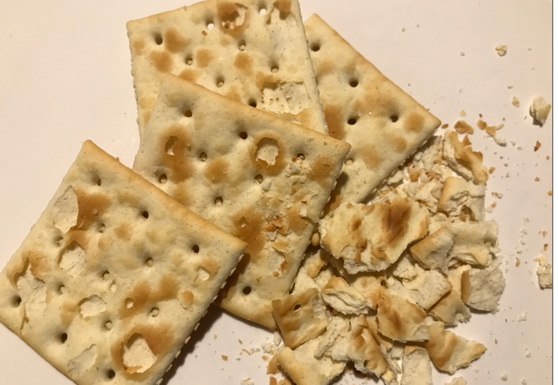
Figure 6. Saltine crackers.
You can see that the Saltine crumbs are pretty uneven with sharp corners. Once, I had a child tell me that it felt like glass in his mouth. Thus, Saltines are going to be a bigger ask from a sensory perspective. They are still salty, but one of the properties of Ritz crackers is you can make them very fine and powdery which makes them more meltable than the saltines. And with a Saltine cracker, although it mixes with saliva well, it sits on your tongue like a little glob and more of a lasting feeling on your tongue. This is going to be very different ask for the children we are working with.
Fruit Loops are shown in Figure 7.
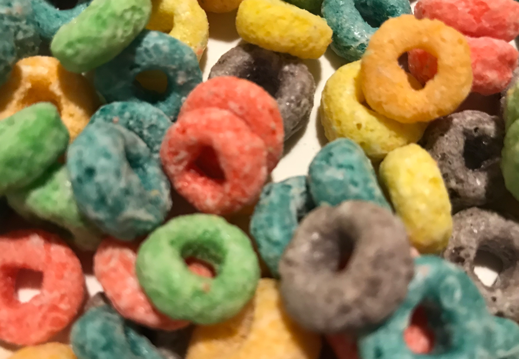
Figure 7. Fruit loops.
I like to use Fruit Loops because they are playful, and kids can sort them by color. When crumbed, they get very fine and powdery, or you can make them coarse. If the child does not like sound, we can grade the sound experience for the child. When you put these in your mouth, they have kind of a tangy taste so very quickly your salivary glands dump saliva. This can be a good thing in some cases, but for others, it could be too much. It is a "wake-up" type flavor that can pucker up your mouth. So, we want to pay attention to those different variables.
Textures and Sensory Differences
- Textures are a roadblock for many children in developmental eating transitions
- Think of food texture words
- What are the food words we use talking about children’s food?
Let's think for a second about the textures and their sensory differences that we talk about when we are feeding children. What are the food words that we use when we're talking about texture transitions for children? We talk about purees, mashed foods, ground foods, chopped foods, and solid foods. There may be others that you use, but we use this terminology a lot. There are some children that really like puree, but they do not just mean any old puree. They mean baby food puree that is really smooth and not very textured. When we try to help children get from puree towards solids, there are going to be a lot of little tiny steps along the way, and within puree, there will be a significant amount of texture changes that we need to think about. Did you know that in Japan they have 408 texture words that relate to food? In Austria, there are 102. In the United States, we have 78 (Mouritsen & Stybaek, 2017). I do not know if I could even name them all. As we stated, pureed, mashed, ground, chopped, and solid are five examples, but there are a lot more that we could think about. We have to be very careful when we are doing textures transitions for children because there are so many sensory differences and sensory variables.
- Think about the texture differences, subtleties? a continuum?
- Smooth, coarse, dry, moist, wet, solid, slippery, grainy, rubbery, viscous, thin thick, chewy, scattery, crunchy, soft, runny, crispy, hard, juicy, springy, lumpy, chunky, stiff, rough, gritty, hot/cold, lukewarm, sticky, crumbly, light, airy, meltable…
